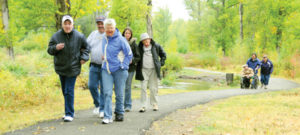Choosing a Walking Exercise Program
 Below you will find some sample exercise programs. See a doctor before beginning any exercise program. Have a physical examination and have the Dr. recommend one of the exercise programs or another version for you. If your doctor does not make a recommendation, Make a self-assessment of your physical condition and choose a program yourself. Once you’ve begun the program, reassess your choice. If you feel like you are overexerting yourself, slow down. If you aren’t feeling the effect from your walk, try a faster pace.
Below you will find some sample exercise programs. See a doctor before beginning any exercise program. Have a physical examination and have the Dr. recommend one of the exercise programs or another version for you. If your doctor does not make a recommendation, Make a self-assessment of your physical condition and choose a program yourself. Once you’ve begun the program, reassess your choice. If you feel like you are overexerting yourself, slow down. If you aren’t feeling the effect from your walk, try a faster pace.10,000 steps a day program:this is a great and easy program to get you started on your lifetime walking habit. The 10K at day program is to walk 10,000 steps a day, which exceeds the Surgeon General’s physical fitness recommendations of 30 minutes of exercise three times a week. When you accomplish this you will be burning more calories and you’ll be walking your way to a healthier life.
Your pedometer will count every step you take during the day. It will add new motivation to your exercise and program will keep you focused on your goal: 10,000 steps a day
You may find however that your steps vary day to day due to activities. A suggestion is that you monitor your weekly, not daily totals. Going for 70,000 steps per week rather than 10,000 steps per day can help ward off those feelings of failure. If you’re trying to lose weight, you might even try to walk 12,000 steps per day, while maintaining a reasonable diet and drinking lots of water.
To get started on your 10 K a D program, put on your step pedometer in the morning and start walking. Keep track of your daily steps on the notepad, calendar, or in a walking journal. After three days calculate the average number of the steps you’ve taken for three days, this is your start point.
You may wonder how far you have walked, having taken so many steps. One way you can determine the distance you have traveled is to own a distance pedometer. There are put on the nurse that can tell you steps, distance, calories burned, time spent exercising, and heart rate.
Exercise Program – Dues and don’ts:
- Do see a doctor and talk to your doctor before beginning an exercise program and get a full physical. Let the doctor choose an exercise program that is right for you.
- Do drink water, extremely important on hot and humid days, drink before, during and after your walk.
- Do you eat well, avoid Junkfood and all products with high-fat think cholesterol. Eat 3 moderately sized meals a day.
- Do you choose a smooth level surface which will result in less fatigue and fewer injuries.
- Don’t continue walking if you have chest pain, or overly tired, dizzy, feel pain or experience shortness of breath or can’t hold a conversation with someone. Stop walking and immediately see a doctor.
- Don’t walk right after or before meals. Walking two hours after meal and waiting 20 minutes after you walked to eat should be sufficient
- Don’t walk outdoors if it is extremely cold, hot or humid. Try an inside track or mall instead.
- Don’t walk on ice or walk during a lightning storm. Head for cover but not under a tree.
It’s now up to you!
Now that you have found out all about walking, it’s up to you to make walking a part of your life, once you’ve selected one of the above exercise programs or have designed your own is a good idea to do the following: set goals, make a time commitment, keep track of your progress.
Set goals: goal setting is one of the most important aspects of any exercise program. While one of the above exercise programs is a start, it is still necessary to set your own personal short-term, intermediate and long-term goals. These goals may be based on weight, distance, time, heart rate or any other measurable unit. Try to avoid having bagels such as I want to feel better. What you have set a goal, make a plan to reach these goals. Part of this plan should include the above exercise programs, but may include non exercise actions such as going on a diet.
Make a time commitment: find time for walking. It may not be necessary to walk the same time every day, but make sure you schedule your walks. Every time you miss a session, it will be that much harder to reach your goals.
Keep track: measure your walk, record those measurements and write down your progress in reading your goals. The predominant are you just purchased is perfect for helping you keep track of your walking accomplishments. Keeping a journal is a perfect way to keep track of your walking program.
For more posts about exercise programs, click here.
You can follow any responses to this entry through the RSS 2.0 feed. You can leave a response, or trackback from your own site.


Leave a Reply